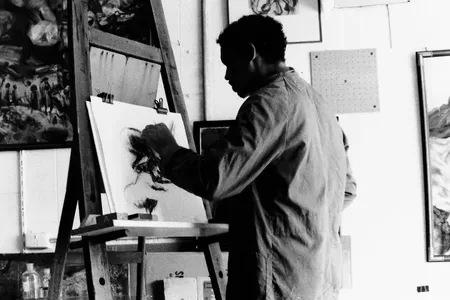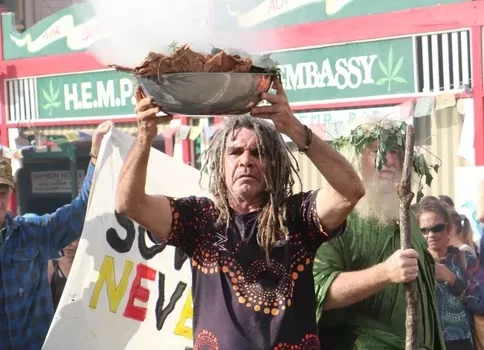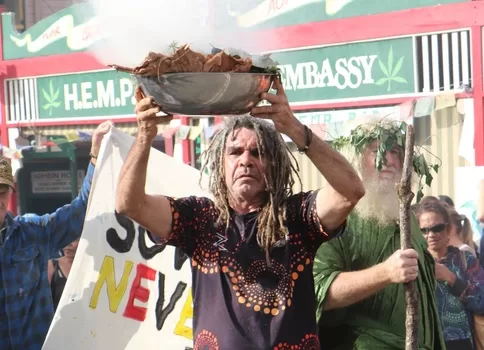The first Aquarius Festival in Nimbin was celebrated in 1973. Among its notable achievements was the inaugural “Welcome to Country” ceremony that welcomed non-Indigenous Australians to the land.
The 1973 Aquarius Festival featured a welcome ceremony led by Uncle Lyle Roberts and song man Uncle Dickee Donnelly, the last known initiated men of the Bundjalung people.
Aboriginal and Torres Strait Islander communities had traditionally welcomed each other for thousands of years before British colonists arrived in 1788. Indigenous travellers entering another’s territory needed to seek permission from the land’s people, acknowledging and adhering to the rules of the country being entered.
The original Aquarius Festival directors, Johnny Allen and Graeme Dunstan, employed by the Aquarius Foundation, the cultural arm of the Australian Union of Students, were unaware of this history.
1973 Aquarius Arts and Lifestyle Festival
The 1973 Aquarius Festival, hosted in Nimbin, New South Wales, by the Australian Union of Students (AUS), is recognised as Australia’s first publicly acknowledged Welcome to Country, although it was not termed as such at that time.
Organisers of this alternative lifestyle festival were prompted by Indigenous activist Gary Foley to obtain permission from local traditional owners to conduct the event on their land.


Following Foley’s advice, the Aquarius organisers dispatched representatives from AUS including artist Bauxhau Stone, an African Kalahari bushman had experience working with Indigenous groups, to invite Aboriginal people to the festival.
Funding from the Whitlam government supported busloads of indigenous attendees to Nimbin.
An estimated 200 to 800 Indigenous Australians from around the country participated in the two-week festival, signifying a substantial fostering of connections with Australia’s counterculture.
The 1973 Aquarius Festival featured a welcome ceremony led by Uncle Lyle Roberts and song man Uncle Dickee Donnelly, the last known initiated men of the area.
Years later, Rhoda Roberts AO coined the term “Welcome to Country,” reflecting on the opportunity for Australians to have respect for and care for the country. The acknowledgment has become widely accepted, paving the way for the next layer of understanding.
Richard Walley and Ernie Dingo
Many erroneous media posts are attributing the first “Welcome to Country” to Ernie Dingo and Richard Walley who devised a ceremony for a contingent of Māori and Cook Islander dancers participating in the Perth International Arts Festival in 1976.
Maori and Cook Islander dancers were declining to perform without being welcomed onto Whadjuk Nyoongar land at The University of Western Australia.
The Guardian and London Daily Mail and Australian Geographic all make the erroneous claim. Even AAP Factcheck is misleading, not once but twice.
While Uncle Dingo and Walley’s ceremony was important because it continued and spread the tradition to a wider audience, the welcome ceremony to the land at the 1973 Nimbin Aquarius Festival by Uncle Lyle Roberts and Uncle Dickee Donnelly beat them to it by three years.
A longer and more detailed version of the story of the first Welcome to Country cermony is here.
What’s the difference between Welcome to Country, Smoking Ceremony and Acknowledgement of Country?
Welcome to Country
A ‘Welcome to Country’ is a formal greeting extended onto Aboriginal Land by an Elder or Aboriginal person native to that land, or an Aboriginal person authorised by the Local Aboriginal Land Council. This welcome is exclusively conducted by a Traditional Custodian from the specific Country where the event is located, typically a respected Elder from the local community. The Elder extends a welcome to people on their land.


Smoking Ceremony
A Smoking Ceremony is conducted in Aboriginal communities to purify a space where the ceremony occurs, fostering peace and acknowledging the event’s significance.
This purification ritual is exclusively performed by an Aboriginal Elder or an individual with specialised spiritual and cultural knowledge.
Given its profound nature, a Smoking Ceremony is usually reserved for special occasions or significant events at locations of spiritual importance.
Acknowledgement of Country
An Acknowledgement of Country is a declaration recognizing the Traditional Custodians of the land. It can be offered by individuals, both Aboriginal and non-Aboriginal.
Related Stories
Era of Change: 1960s-70s Revolution & Welcome to Country
The Block at Redfern, Sydney, site of the 2004 Redfern riots
New Cultural Rights Legislation targets fake Indigenous art
Artist and Activist, Uncle Bruce Shillingsworth
The Bulletin’s 2004 story on the Pinputi Nine
Uluru Statement from the heart & Paul Keating’s 1992 Redfern Speech
Where did the term “Woke” come from? What does Woke mean?







